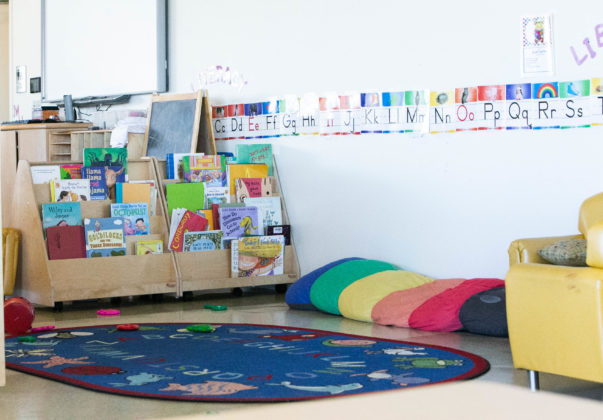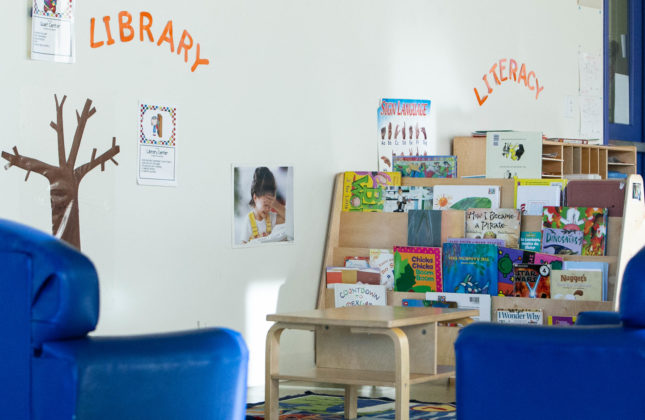Deborah Lamb Osborn was in the process of a divorce when she moved to Utah.
The mother of two from Alaska, who works for the Veterans’ Administration and doesn’t receive child support, qualified for state-assisted child care when she first came to Utah. Then she received a raise at work, and the increase in salary made her ineligible for state-assisted child care. The raise, however, wasn’t as much as she lost in state assistance.
“I would have rather not had my raise, because (the state) went from paying $825 a month to nothing. I didn’t get an $825 a month raise,” Osborn said. “There’s no help for single working moms. If you make too much money to be on the poverty level, forget help.”
Osborn has made her situation work through an understanding child care provider that allows her to pay only hourly, which she said it doesn’t do for everyone. She also works from home, except for one day a week when she goes into the office.
“If I didn’t have (child care), I would not be able to work,” Osborn said, adding she doesn’t have any nearby family or friends to ask for help.
Osborn is far from alone in her single parent status. Nationally, about 19.65 million children lived with one parent in 2018, with nearly 16.4 million with their mother only, according to data company Statisa.
37,690 Utah households are headed by a woman living with her own children under age 18 with no husband present, according to a 2018 research brief from the Utah Women and Leadership Project called “Childcare: What Utahns Need to Know.”
Additionally, 52 percent of Utah kids under age 6 have all available parents in the workforce, according to 2017 data from the Kids Count Data Center. The Utah Women and Leadership Project’s brief notes, “We must not forget that in many households with children, ‘all available parents’ is just one.”
Subsidies
According to the Utah Office of Child Care, a child care assistance payment is “a subsidy that helps parents pay for approved child care while at work or looking for work.” The payment amount is determined by the Utah Department of Workforce Services and is paid directly to the child care provider. Workforce Services also determines the parents’ copayment.
For example, if a child care provider’s monthly charge is $530, Workforce Services might pay a $433 subsidy and determine the copay to be $77. This leaves a $20 out-of-pocket payment for the parent, which, added to the $77 copayment, totals $97 paid by the parent to the child care provider.
Maximum monthly child care payments are based on the local market, the child care provider type and the children’s ages. Additionally, child care assistance is determined by income, which is limited to 85 percent of the state median income. In federal fiscal year 2018, the estimated state median income for a four-person family was $74,437, according to the Low-Income Home Energy Assistance Program Clearinghouse website.
Copayment requirements are determined by income range, household size and the number of children in a family.
KC Hutton, the program manager at the Utah Office of Child Care, said the office provides a variety of types of child care assistance, but the most common is employment-supported child care.
She said because the Office of Child Care wants to support continuity of care for children, families who are eligible to receive employment-supported child care have 12-month eligibility periods and during which changes in eligibility don’t occur unless the family reaches 85 percent of the state median income.
“In many situations, this allows families to receive raises throughout a year and not have those raises impact the assistance they receive during that eligibility period,” she said.
Single parent students
To receive state child care assistance, employed single parents must work an average of 15 hours a week, according to the Utah Department of Workforce Services website. If parents are also in school or a training program, they must verify their course of study, schedule and graduation date.
UVU’s Wee Care Child Care Center Director Todd Harper said about 30 to 40 percent of the families who use the facility are single-parent families. He said the challenge with state subsidies is that single parent students have to work at least 15 hours a week to qualify for state child care assistance.
“What I have learned from the families here is that it is a struggle to go to school, raise a family and work to provide,” he said, adding that Wee Care gives priority to single-parent families and there are single parent scholarships offered through UVU’s Women’s Success Center.
Cheryl Preece-Smith, director of the Little Brigham Aggies day care at USU-Brigham City, said the day care takes state assistance for child care and a majority of the parents using their facility are single parents. Most work lower-paying jobs, and she sees the same problem Todd Harper does at Wee Care: student parents struggling to both attend school and work the hours required to qualify for state child care assistance.
“In other states, if you even just go to school, but don’t work, you qualify for state assistance,” she said. “Our state doesn’t specifically pay for school or study hours for parents. In a state with so many children and with state goals that want to lift families out of poverty, this change would make a huge difference in completion and persistence rates for some single parent college students.”
‘A vicious cycle’
Osborn said she only works because she has to, calling the three months she was able to stay home with her daughters when she first moved to Utah “the best three months of my life.”

She said it’s hard when her daughters want her to come on field trips or help in their classrooms and she has to say “no.”
“I don’t get to do those fun things I remember my mom doing with me when I was a kid,” Osborn said.
She also said the mental health challenges of being a single parent are overwhelming. Some nights she feels like she snaps at her kids more because she’s tired from working a nine-hour day and being a full-time mom when she gets home.
But what she struggles with the most is seeing moms working hard to make ends meet but losing state assistance while there are moms who don’t work and live off state assistance.
“I have a huge issue with that,” she said. “But I have to work to support my family. It’s just kind of a vicious cycle.”
Provo offers single parents education and support groups at the Family Academy, and the Utah Office of Workforce Services has a website page dedicated to various child development, food, housing, medical, legal and other resources for parents.
Resources for children include the Utah Summer Food Service program, the Utah Children’s Health Insurance Program and the Utah Head Start Association.



















